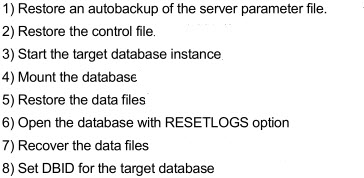出自:Oracle认证
You are using Recovery Manager (RMAN) with a recovery catalog to back up your production database. The backups and the archived redo log files are copied to a tape drive on a daily basis. Because of media failure, you lost your production database completely along with the recovery catalog database. You want to recover the target database and make it functional. You consider performing the following steps to accomplish the task:  Which option illustrates the correct sequence that you must use?()
Which option illustrates the correct sequence that you must use?()
A:8, 1, 3, 2, 4, 5, 7, 6
B:1, 8, 3, 4, 2, 5, 7, 6
C:1, 3, 4, 2, 8, 5, 6, 7
D:1, 3, 2, 4, 6, 5, 7, 8
The ORDERS table has these columns: ORDER_ID NUMBER(4) NOT NULL CUSTOMER_ID NUMBER(12) NOT NULL ORDER_TOTAL NUMBER(10,2) The ORDERS table tracks the Order number, the order total, and the customer to whom the Order belongs. Which two statements retrieve orders with an inclusive total that ranges between 100.00 and 2000.00 dollars? ()
A:SELECT customer_id, order_id, order_total FROM orders RANGE ON order _ total (100 AND 2000) INCLUSIVE;
B:SELECT customer_id, order_id, order_total FROM orders HAVING order _ total BETWEEN 100 and 2000;
C:SELECT customer_id, order_id, order_total FROM orders WHERE order _ total BETWEEN 100 and 2000;
D:SELECT customer_id, order_id, order_total FROM orders WHERE order_total>= 100 and <= 2000;
E:SELECT customer_id, order_id, order_total FROM orders WHERE order_total>= 100 and order_total <= 2000;
Examine the description of the EMPLOYEES table: EMP_ID NUMBER(4) NOT NULL LAST_ NAME VARCHAR2(30) NOT NULL FIRST_NAME VARCHAR2(30) DEPT_ID NUMBER(2) JOB_CAT VARCHAR2(30) SALARY NUMBER(8,2) Which statement shows the department ID, minimum salary, and maximum salary paid in that department, only if the minimum salary is less than 5000 and maximum salary is more than 15000?()
A:SELECT dept_id, MIN(salary), MAX(salary) FROM employees WHERE MIN(salary) < 5000 AND MAX(salary) > 15000;
B:SELECT dept_id, MIN(salary), MAX(salary) FROM employees WHERE MIN(salary) < 5000 AND MAX(salary) > 15000 GROUP BY dept_id;
C:SELECT dept_id, MIN(salary), MAX(salary) FROM employees HAVING MIN(salary) < 5000 AND MAX(salary) > 15000;
D:SELECT dept_id, MIN(salary), MAX(salary) FROM employees GROUP BY dept_id HAVING MIN(salary) < 5000 AND MAX(salary) > 15000;
E:SELECT dept_id, MIN(salary), MAX(salary) FROM employees GROUP BY dept_id, salary HAVING MIN(salary) < 5000 AND MAX(salary) > 15000;